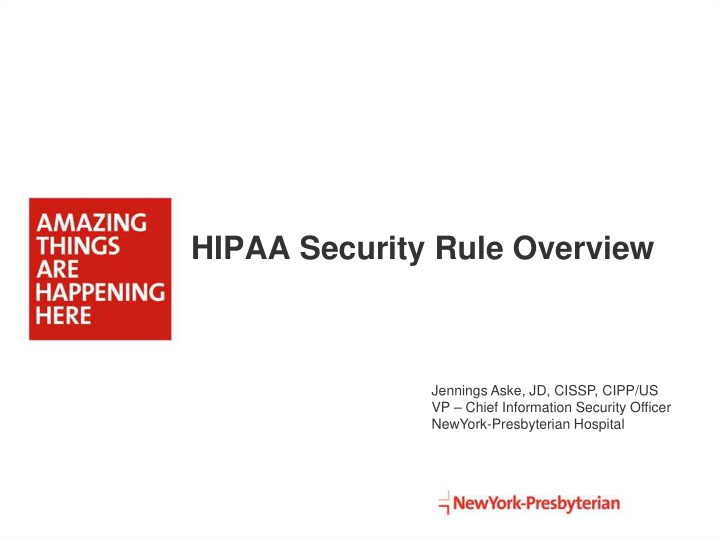



HIPAA Security Rule Overview Jennings Aske, JD, CISSP, CIPP/US VP – Chief Information Security Officer NewYork-Presbyterian Hospital
The Use of Electronic Technology in Healthcare Over the past decade the health care industry began to rely more heavily on the use of electronic information systems. Providers use clinical applications such as computerized physician order entry (CPOE) systems, electronic health records (EHR), and radiology, pharmacy, and laboratory systems. Health plans are providing access to claims and care management, as well as member self-service applications. While this means that the medical workforce can be more mobile and efficient, the rise in the adoption rate of these technologies increases the potential security risks.
3 3
The health care system cannot deliver effective and safe care without deeper digital connectivity. If the health care system is connected, but insecure, this connectivity could betray patient safety . . . . Our nation must find a way to prevent our patients from being forced to choose between connectivity and security. - Health Care Industry Cybersecurity Task Force, June 2017 Report On Improving Cybersecurity In The Health Care Industry 4 4
HIPAA Security Rule Purpose Prior to HIPAA, no generally accepted set of security standards or general requirements for protecting health information existed in the health care industry. The Security Rule established a national set of security standards for protecting certain health information that is held or transferred in electronic form. The Security Rule operationalizes the protections contained in the Privacy Rule by addressing the technical and non-technical safeguards that organizations covered entities must put in place to secure individuals’ “electronic protected health information” (e-PHI). Within HHS, the Office for Civil Rights (OCR) has responsibility for enforcing the Privacy and Security Rules through voluntary compliance activities, audits, and civil money penalties.
HIPAA Security Rule Overview A major goal of the Security Rule is to protect the privacy of individuals’ health information while allowing covered entities to adopt new technologies to improve the quality and efficiency of patient care. The Security Rule is designed to be reasonable and scalable so a covered entity can implement policies, procedures, and technologies that are appropriate for the entity’s particular size, organizational structure, and risks to consumers’ e-PHI. The Security Rule applies to health plans, health care clearinghouses, and to any health care provider who transmits health information in a standardized electronic form, and to their business associates.
HIPAA Security Rule General Requirements The Security Rule requires covered entities to maintain reasonable and appropriate administrative, technical, and physical safeguards for protecting e-PHI. Specifically, covered entities must: Ensure the confidentiality, integrity, and availability of all e-PHI they create, receive, maintain or transmit; Identify and protect against reasonably anticipated threats to the security or integrity of the information; Protect against reasonably anticipated, impermissible uses or disclosures; and Ensure compliance by their workforce.
Reasonable and Scalable Requirements Under the Security Rule, when a covered entity is deciding which security measures to use, the Rule does not dictate those measures but requires the covered entity to consider: Its size, complexity, and capabilities, Its technical, hardware, and software infrastructure, The costs of security measures, and The likelihood and possible impact of potential risks to e-PHI. Covered entities must continually review and modify their security measures to continue protecting e-PHI in a changing environment.
Risk Analysis: The Key to the Security Rule The Administrative Safeguards provisions in the Security Rule require covered entities to perform risk analysis as part of their security management processes. A risk analysis helps a covered entity determine which security measures are reasonable and appropriate for a particular covered entity. A risk analysis helps affects the implementation of all of the safeguards contained in the Security Rule.
Risk Analysis: The Key to the Security Rule A risk analysis process includes, but is not limited to, the following activities: Evaluate the likelihood and impact of potential risks to e-PHI; Implement appropriate security measures to address the risks identified in the risk analysis; Document the chosen security measures and, where required, the rationale for adopting those measures; and Maintain continuous, reasonable, and appropriate security protections. Risk analysis should be an ongoing process, in which a covered entity periodically evaluates the effectiveness of security measures put in place, and regularly reevaluates potential risks to e-PHI.
Administrative Safeguards Security Management Process – overall covered entity security program backed by policies and procedures Security Personnel – a designated person at the covered entity with responsibility for compliance Information Access Management – processes for ensuring that only authorized individuals can access e-PHI Workforce Training and Management – education and awareness for all individuals as to their responsibility for security Evaluation – mechanisms for evaluating compliance with the Security Rule, and the effectiveness of the covered entity’s security posture
Physical Safeguards Facility Access and Control – policies and procedures to limit physical access to e-PHI and computing systems Contingency Operations – safeguards to secure e-PHI during a disaster or emergency Facility Security Plan – overall plan for securing a covered entity’s facilities Workstation and Device Security – policies procedures for securing access to computing devices
Technical Safeguards Access Control – the ability to technically restrict access to e-PHI and computers Audit Controls – the ability to review and detect access to e-PHI, including potential unauthorized access Integrity Controls – the ability to ensure that e-PHI hasn’t been altered Transmission Security – the ability to protect e-PHI as it travels over an ”untrusted” network such as the internet
Security Rule Summary Protects e-PHI by establishing a general information security framework; Provides flexibility of approach; and Requires risk analysis and risk management, along with specific administrative, physical, technical safeguards
Recommend
More recommend